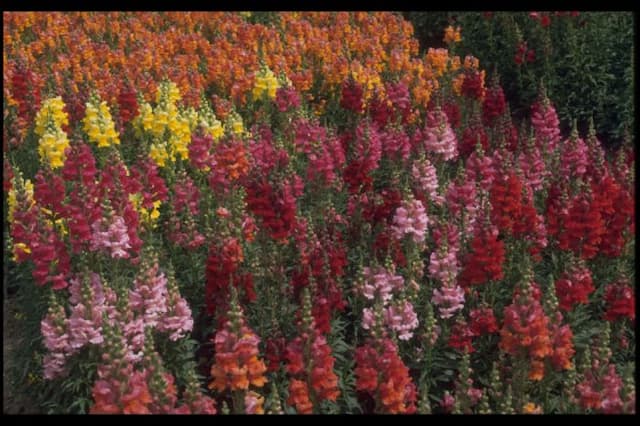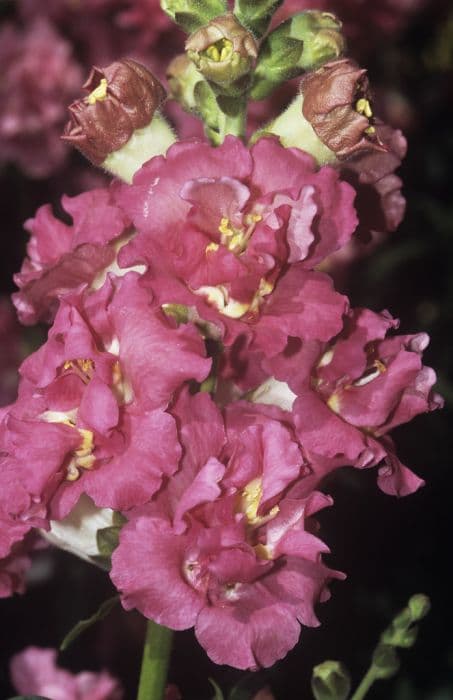Snapdragon Antirrhinum majus 'Madame Butterfly' (mixed) (d)

ABOUT
The plant commonly known as Snapdragons 'Madame Butterfly' (mixed) is celebrated for its striking and unique flowers. The blooms of this variety set themselves apart with a distinctive double-flower form, resembling the ruffled petals of an open peony. The flowers come in a lively mix of colors which may include shades of red, pink, yellow, orange, white, and purple, often displaying delightful bicolor patterns where a lighter color graces the petal edges as if they have been artistically outlined. The Snapdragon's blooms cluster along a tall, sturdy stem, rising above the foliage in an attractive spire. The leaves of the plant are narrow and lance-shaped, bearing a medium green color that serves as a fresh backdrop to the colorful flowers. This variety of Snapdragon tends to branch more than others, leading to an abundance of flowers crowding the top portion of the stems. A standout feature is the flower's ability to open and close its 'jaws' when gently squeezed on the sides, which is a characteristic that makes it particularly entertaining for children and adults alike. The shape and movement of the Snapdragon's blooms are reminiscent of mythical dragons, which is how they've earned their enchanting name. The vivid colors and dramatic shape of the flowers create a sense of whimsy and charm in any garden or bouquet.
About this plant
 Names
NamesFamily
Plantaginaceae.
Synonyms
Snapdragon, Dogflower, Lion's Mouth, Dragon Flower, Calf's Snout.
Common names
Antirrhinum majus.
 Toxicity
ToxicityTo humans
Snapdragon, generally considered a non-toxic plant to humans, does not pose serious risks if ingested in small quantities. However, consuming large amounts could potentially cause mild gastrointestinal upset, but significant toxicity is unusual.
To pets
Snapdragon is also non-toxic to pets and is not known to cause serious problems if ingested. While it is not considered poisonous, as with any non-food plant, ingestion could potentially lead to mild gastrointestinal irritation.
 Characteristics
CharacteristicsLife cycle
Annuals
Foliage type
Deciduous
Color of leaves
Green
Flower color
Mixed
Height
2 feet (60 cm)
Spread
1 foot (30 cm)
Plant type
Herb
Hardiness zones
9
Native area
Mediterranean
Benefits
 General Benefits
General Benefits- Attracts Wildlife: Snapdragons are known to attract pollinators such as bees and butterflies, which are essential for any healthy garden.
- Color Variety: They come in a wide range of colors, offering versatility and vibrancy to any garden setting.
- Aesthetic Appeal: With elegant double flowers, Snapdragons add a touch of classic beauty and sophistication to landscapes and floral arrangements.
- Cut Flower Use: Snapdragons are excellent for cut flower arrangements as they have a long vase life and enhance the beauty of bouquets.
- Easy to Grow: They are relatively easy to cultivate and can thrive in a variety of climates, making them accessible to many gardeners.
- Cottage Garden Style: Snapdragons are ideal for creating a traditional cottage garden look, thanks to their height and form.
- Seasonal Interest: Snapdragons provide a long flowering period, from spring into fall, ensuring regular bursts of color in the garden.
- Edging and Borders: Their upright habit makes them suitable for adding structure to edges and borders within garden design.
 Medical Properties
Medical PropertiesThis plant is not used for medical purposes.
 Air-purifying Qualities
Air-purifying QualitiesThis plant is not specifically known for air purifying qualities.
 Other Uses
Other Uses- Photography: The unique form and vivid colors of Snapdragon 'Madame Butterfly' make it a popular choice for photographers looking to add interest to garden and floral compositions.
- Educational Tool: Snapdragon 'Madame Butterfly' can be used in educational settings such as schools gardens to teach students about plant biology, pollination, and the diversity of flowering plants.
- Symbolism: Snapdragons are associated with grace and strength, and they can be used in literary or artistic works to symbolize these qualities.
- Crafts: The flowers of Snapdragon 'Madame Butterfly' can be dried and used in floral crafts such as wreath-making or potpourri.
- Culinary: While not a common culinary plant, the petals of some snapdragon varieties are edible and may be used as a garnish for salads or desserts for a splash of color (ensure edibility and absence of pesticides before consuming).
- Children’s Games: The "snap" feature of the Snapdragon 'Madame Butterfly' flowers can be used in children’s games, where kids can gently squeeze the sides of the flower to make it "talk."
- Mood Enhancer: The bright colors and unusual shape of the Snapdragon 'Madame Butterfly' can be used to create an uplifting and whimsical atmosphere in a space.
- Garden Design: Snapdragon 'Madame Butterfly' can be used in garden designs to provide vertical interest and texture due to its tall spiky form.
- Holiday Decor: The Snapdragon 'Madame Butterfly' flowers can be incorporated into festive holiday decorations, such as creating a natural Easter basket or a centerpiece for spring celebrations.
- Ecological Benefits: Planting Snapdragon 'Madame Butterfly' can provide a habitat and nectar source for beneficial insects such as bees and butterflies, supporting local biodiversity.
Interesting Facts
 Feng Shui
Feng ShuiSnapdragons are not specifically mentioned in traditional Feng Shui practice; however, they could be utilized like other flowering plants to promote positive chi and bring in vibrant energy. Typically, healthy flowering plants are believed to foster good luck, love, and abundance, so placing Snapdragons in areas of your home such as the living room or garden might enhance these aspects according to Feng Shui principles.
 Zodiac Sign Compitability
Zodiac Sign CompitabilitySnapdragons are not used in astrology practice.
 Plant Symbolism
Plant Symbolism- Deception or Grace: The common name for Antirrhinum majus is "Snapdragon", and due to its unique flower shape, which resembles a dragon's mouth that opens and closes when laterally squeezed, it symbolically represents both deception and grace.
- Strength: Snapdragons are also seen as symbols of strength, resilience, and protection due to their ability to grow in rocky areas and their use in folk medicine as a protective charm against falsehood.
- Power: The dragon imagery associated with snapdragons conveys a sense of power and might, often symbolizing an inner strength in overcoming difficult situations.
 Water
WaterSnapdragon 'Madame Butterfly' should be watered regularly to keep the soil consistently moist but not waterlogged. During active growth periods, typically in spring and summer, watering may be required more frequently, potentially every few days, depending on weather conditions. It is essential to avoid overhead watering that can promote fungal diseases; instead, water at the base of the plant to keep foliage dry. Aim for about 1 inch of water per week as a rule of thumb. If natural rainfall is insufficient, supplement with additional watering.
 Light
LightSnapdragons like 'Madame Butterfly' thrive in full sun but can tolerate partial shade. The ideal location offers at least 6 to 8 hours of direct sunlight daily. Too much shade can lead to leggy growth and fewer blooms, so ensure that your plant receives plenty of light for optimal flowering.
 Temperature
TemperatureSnapdragons like 'Madame Butterfly' prefer cooler temperatures and can tolerate light frosts. The ideal temperature range for active growth is between 50 to 70 degrees Fahrenheit. While they can survive in temperatures as low as 35 degrees Fahrenheit and as high as 80 degrees Fahrenheit, prolonged exposure outside this range may affect the plant's vitality and blooming.
 Pruning
PruningPruning Snapdragons 'Madame Butterfly' encourages bushier growth and more blooms. Deadhead spent flowers regularly to promote continuous blooming throughout the season. In midseason, cut back the main stems by one-third to rejuvenate the plant and encourage a second flush of flowers. The best time for pruning is after the first wave of flowering has subsided.
 Cleaning
CleaningAs needed
 Soil
SoilSnapdragon 'Madame Butterfly' prefers well-draining loam or sandy loam soil with a pH of 6.2 to 7.0. The best soil mix would include two parts peat moss, one part loam, and one part sand or perlite to ensure good drainage and aeration. Organic matter, like compost or well-rotted manure, can be added to enrich the soil and support healthy growth.
 Repotting
RepottingSnapdragon 'Madame Butterfly' generally doesn't require frequent repotting as it's often grown as an annual. However, if grown as a perennial in zones 7-10, it should be repotted or divided every 2-3 years to refresh the soil and to manage its size.
 Humidity & Misting
Humidity & MistingSnapdragon 'Madame Butterfly' thrives in moderate humidity levels, typically around 40-50%. They can tolerate lower humidity conditions, but a consistent level within this range is ideal for optimal growth and flowering.
 Suitable locations
Suitable locationsIndoor
Place in bright, indirect light and avoid overwatering.
Outdoor
Full sun to partial shade, well-draining soil, regular watering.
Hardiness zone
7-10 USDA
 Life cycle
Life cycleAntirrhinum majus 'Madame Butterfly', commonly known as Snapdragon, begins its life cycle with seed germination, which requires consistent moisture and light. Following germination, seedlings emerge and transition to the vegetative stage, growing leaves and stems during favorable spring temperatures. When the plants mature, they enter the flowering stage, producing the distinctive 'snapdragon' blooms that can come in a variety of colors in this mixed variety. The flowers then get pollinated by insects, leading to the development of seed pods in place of the flowers. Once mature, the seed pods split open, dispersing seeds for the next generation. As the weather cools, or in adverse conditions, the plant completes its life cycle, potentially entering a period of dormancy or dying off, depending on climate and care.
 Propogation
PropogationPropogation time
Spring-Early Summer
Snapdragons, including the 'Madame Butterfly' variety, are commonly propagated through seeds. The most popular method of propagation is sowing seeds indoors about 8 to 10 weeks before the last expected spring frost. To do this, spread the seeds on the surface of a moist, well-draining seed-starting mix and lightly press them into the soil, as snapdragon seeds need light to germinate. Covered with a plastic wrap or placed in a greenhouse, the seeds should be kept at a temperature of 65 to 75 degrees Fahrenheit (18-24 degrees Celsius), and they will typically germinate within 7 to 14 days. Once seedlings emerge and grow large enough to handle, they can be transplanted into individual pots and later moved to their final growing location outdoors.




![Snapdragon [Pretty in Pink]](/_next/image?url=https%3A%2F%2Fplants-admin.emdemapps.com%2Fimages%2Fplants%2F%2Fimages%2F604b5cb3b5385.png&w=640&q=75)




